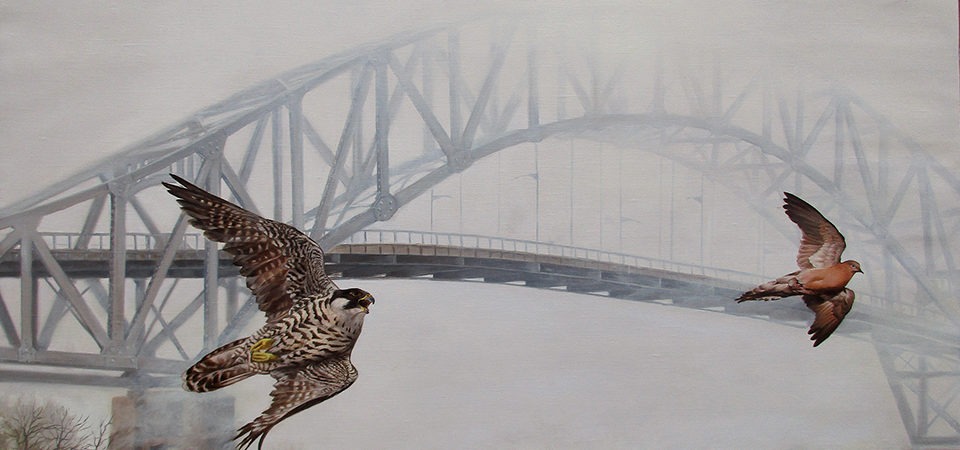The Chase – Peregrine Falcon and Mourning Dove, Oil on linen 24×36″, 2020 (detail)
Sunlight glinting through a raindrop, fog hanging gracefully over the water, the blues and golds of a salt marsh in autumn, punctuated with the calls of gulls. These are the experiences that capture my attention. The beautiful but fleeting world of nature offers an endless source of inspiration for my works.
It all started many years ago, when my Grandmother bought a house in southern Maryland, right across the street from the water. Breton’s Bay, an offshoot of the Chesapeake, was a wonderful place to explore and learn about the natural world. Not only were there abundant sea life, like crabs & fish, but the nearby fields also yielded up their treasures. Wildflowers, butterflies, and birds were everywhere.
One clear and sunny summer day, I came across an old abandoned house hidden just at the edge of the woods. It had become a nesting site for a colony of Barn Swallows. Peeking in through the door at their mud nests, they didn’t seem to mind. Chattering, and flying in and out, they provided easy entertainment for an 8 year old. Thus, began my fascination with birds.
For the past 41 years, I have been fortunate enough to observe and paint wildlife, particularly birds, on both the east & west coasts. In the process of bringing their lives to people through my art, I have become aware of just how human population can effect wildlife in many different ways. I have been very aware of just how much the population has grown. Places that were pristine now have trails. National Parks have become seasonal cities in themselves. That special isolated place we might have kept secret for ourselves, invariably has an occupant already. It’s inevitable that some problems will occur.
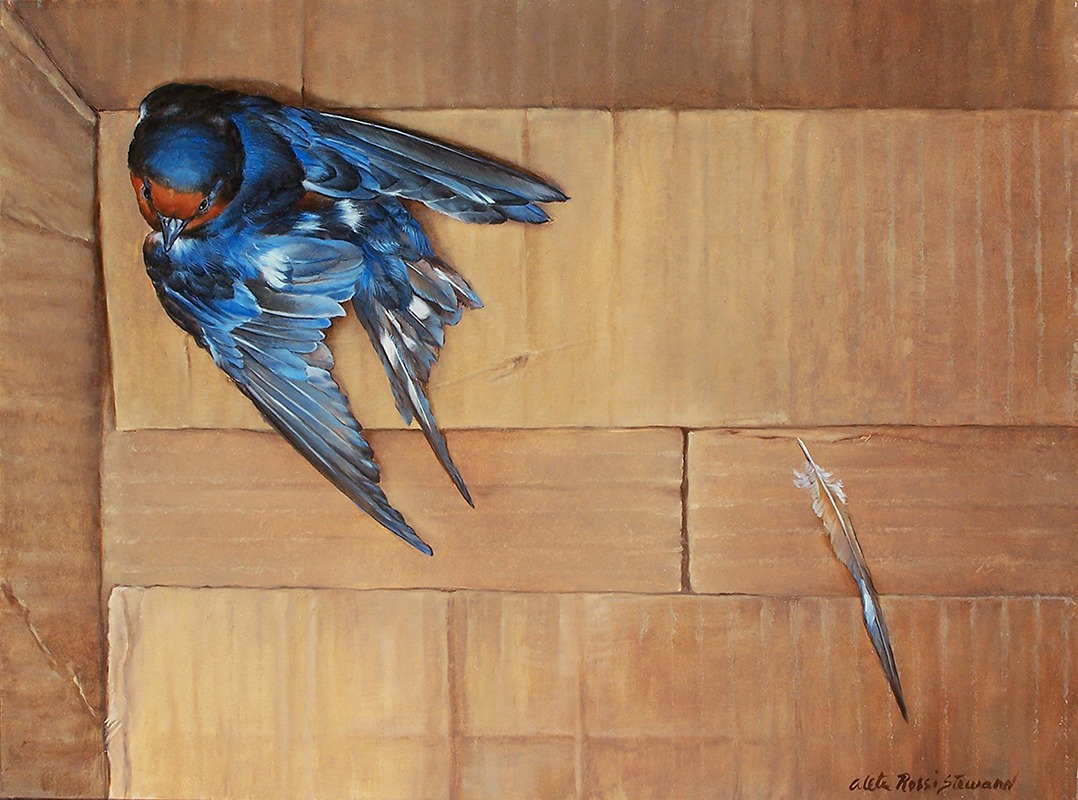
Disintegration
Barn Swallow, oil on panel, 9×12″, 2020
“Disintegration” is a small 9” x 12” oil on panel of a Barn Swallow – the same little birds that started me on this journey. It has become injured in some way, and has been placed into a cardboard box, by some well-meaning person. The theme here is vulnerability. What will happen to the little bird? How did it become injured? It is at the mercy of a human now.
The reality is, many different things could have happened. Birds face threats from the human presence not only directly, but indirectly. Maybe this bird was clawed at by a domestic cat. Cats are, in fact, the number one threat to birds. They kill 2.4 billion birds a year, and have contributed to the extinction of 63 species of birds, mammals and reptiles. Hawaii’s bird population was devastated by cats.
Maybe it was something else though. Maybe the little swallow flew into a glass door or window. Even though we may think of these collisions as being mainly in urban settings, with tall glass skyscrapers, most actually occur with buildings less than 4 stories tall. Collisions with buildings also occur quite often at night because of light pollution as the birds are migrating.
So although humans may be responsible for this situation, at least someone is also taking responsibility for the recovery. The little Barn Swallow was taken to a wildlife rehabilitation center to be examined and released when ready.
“Disintegration” utilized an unusual painting tool: a cardboard box. I actually removed the paper covering from the corrugated cardboard, dipped it in paint, and pressed it onto the panel to create the basic lines of the box. Then came brushwork – blending, details & shading. The bird was painted with oils and sable brushes. First in a rough mode to block everything in, then a second time with the finished details.
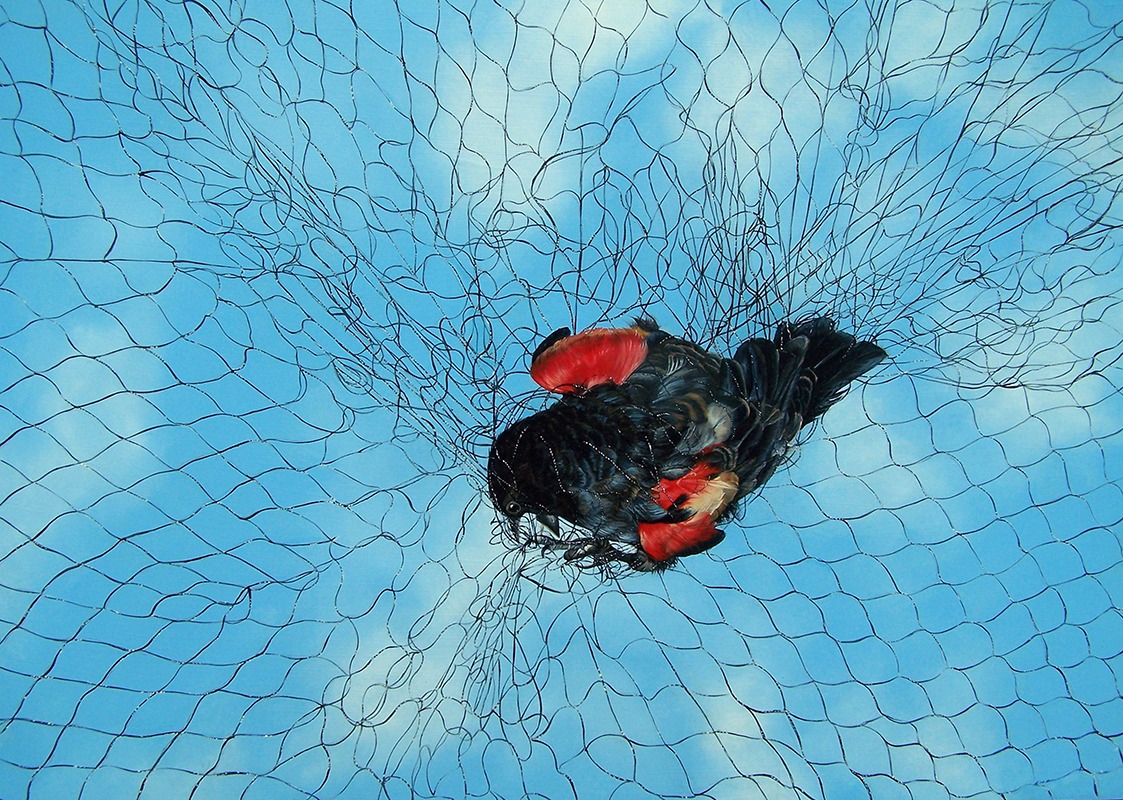
For Your Own Good
Redwing Blackbird, Oil on panel 14×18″, 2016
Central to the preservation of birds is bird banding. “For Your Own Good” is a 14” x 18” oil on panel. A Redwing Blackbird is tangled up, obviously stressed, and fighting to get out of the net. The scene was at a banding station, on the island of Nantucket, under the expert eye of Dr. Richard Veit, from the City University of New York, Staten Island. The birds were gently untangled from the net first, placed in a fabric holding bag, then retrieved, weighed & banded. Lastly, they are set free once again. Banding offers so much information to researchers: population, breeding and territorial behavior, migratory movements, site fidelity, longevity, molting, weight and plumage changes, and more.
This particular Blackbird, although rather fierce looking with his sharp bill, did no harm. In general, when being handled, most birds become quite docile. This Redwing did his part to contribute to the knowledge of all birds, and then quite happily went on his way.
The technique I used for this painting allows for great detail. First, an India ink drawing of the net & bird was completed on the gessobord panel. Then, the colors roughed in – thin enough for the ink drawings to show through. When dry, the netting was carefully painted with black. Next step, when the black lines were dry, was to finish the sky with a few cloudy areas to break up the space. I could still see the netting lines through the painted sky, which is what I wanted. Then the bird was painted in. It took a few days to finish the bird, with rather small kolinsky sable brushes. Careful attention was given to the few brown feathers showing up here and there. Lastly, the netting was finished up, by repainting in black, and adding highlights to the areas of the net that shone in the light. You can see places where the raveled construction of the net shows. It was a very satisfactory piece for me, as it reminds us of the importance a little sacrifice can bring to all.
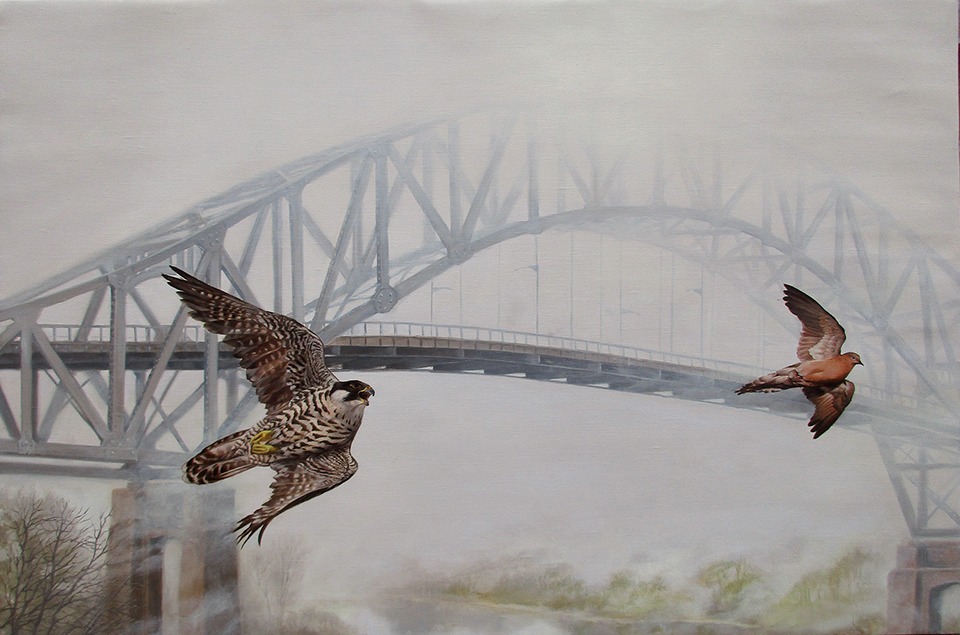
The Chase
Peregrine Falcon and Mourning Dove, Oil on linen 24×36″, 2020
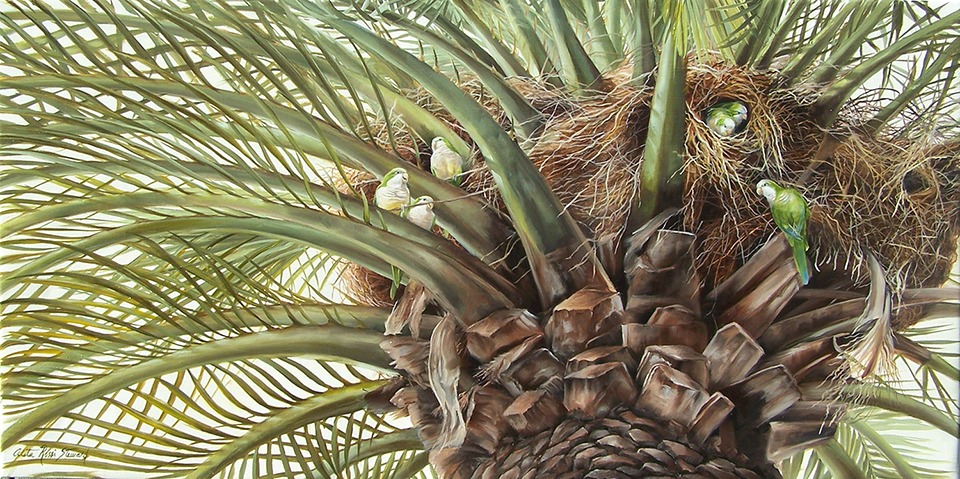
South Beach Condos
Monk Parakeets, Oil on linen 15×30″, 2017
Having really no choice, many birds have become very adept at becoming part of a new environment that we have created. The two paintings illustrated here, “The Chase”, and “South Beach Condos” are examples of that. One early winter day, while traveling over the Cape Cod Canal, I noticed how the fog was gracefully hanging over the top of the bridge’s span, obscuring what may be there. I could only imagine if there was a Falcon above or below me as I drove past. I knew that even though there are numerous natural nesting areas nearby, Peregrines can regularly be found on one or more of our three canal bridges. In general, Peregrines have made a remarkable recovery from the disaster of DDT, and have adapted very well to the new canyons of urban skyscrapers and bridges. This oil on linen captures a moment when the sun peeks through just enough to illuminate the dramatic pursuit.
The lively Monk Parakeets also have adapted, this time to a totally new continent, as they originate in South America. This painting captures a hazy day in South Miami Beach. The Palms provide a great place for the lively birds to build their huge trademark communal nests. Noise is everywhere – the beat of Latin music, the conversations all around, the chattering of the social little birds. They didn’t seem to mind all the activity, and no one seemed to mind them either. They had become just as much a part of Miami Beach as all the other people who have chosen to live there.
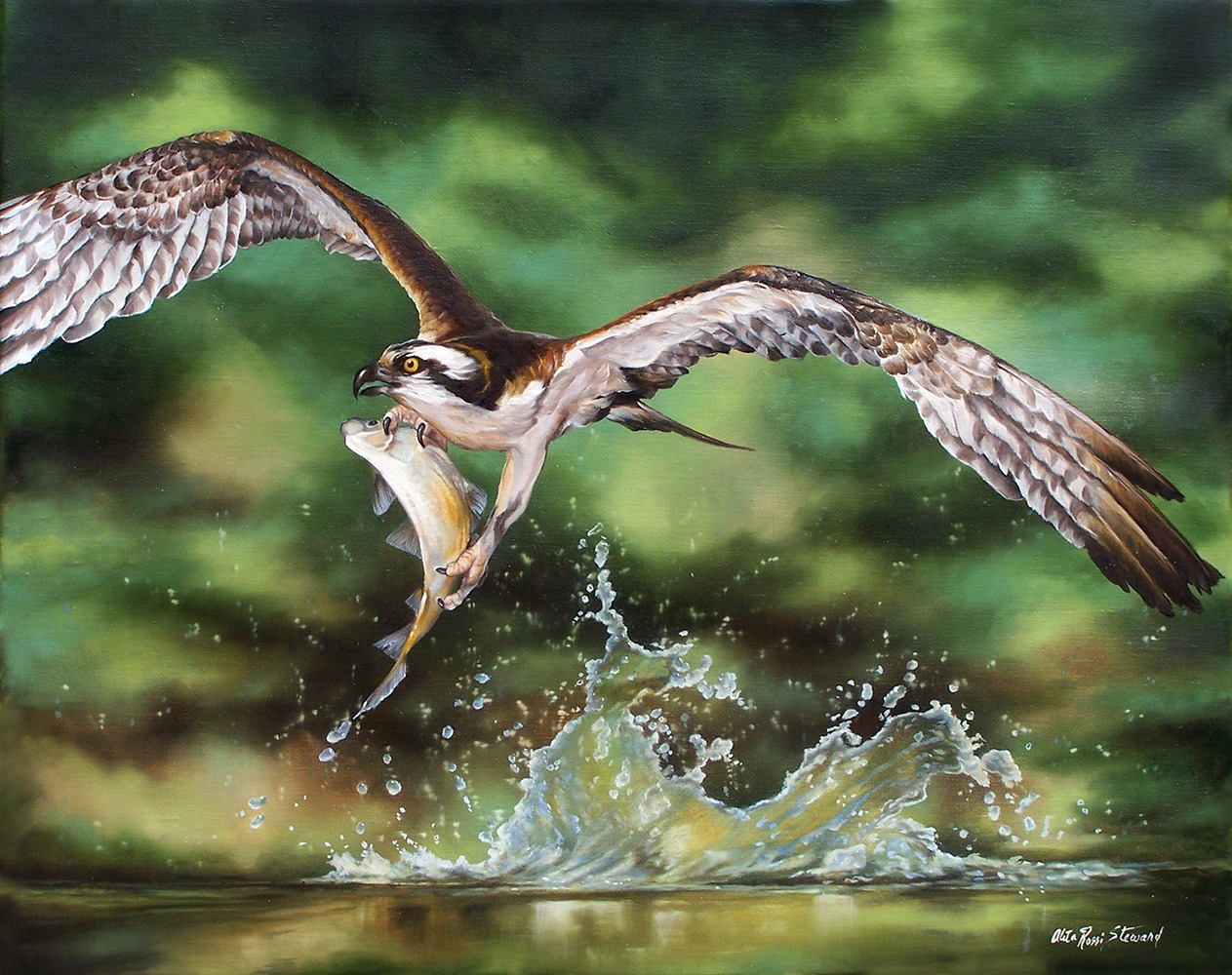
Nice Catch
Osprey, Oil on linen 16×20″, 2019
“Nice Catch” brings to mind that when the realization of environmental needs meets the implementation of conservation efforts, great things can happen. This piece celebrates the fact that clean waterways support fish, and the fish support Osprey. Even on environmentally aware Cape Cod, the influx of year-round residents has added to wastewater woes, and solutions sometimes carry a hefty price tag. But success carries its own rewards.
The Osprey is now a very common bird. It’s especially exciting to see them splash down into the water & come back up with a fish. They may now have a new worry, although some might say a good one – Bald Eagles. For the first time in 115 years, Bald Eagles have returned to my area and are competing for the Osprey. How the drama plays out year after year between these two species remains to be seen.
In conclusion, birds, especially migrating birds face many threats. Many habitats are still being plowed under for agriculture, strip malls & housing developments. Countries in South America where many birds return are also destroying their traditional wintering grounds due to deforestation, mining, and agriculture. Hunting is still going on in many of these places, and some even still use deadly DDT. Ospreys are hunted by fish farmers, as they pass by. Others are subject to unsustainable hunting practices. But we can work together to develop solutions and turn things around. Great progress has already been made.
In my work, I want to keep wildlife at the forefront. Passing by a favorite painting can remind us to experience nature, appreciate it, and become more involved. The more we learn, the better prepared we can be to do what’s needed.
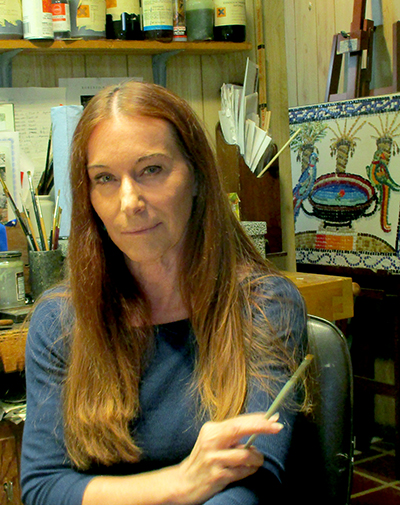
Aleta Rossi Steward is an artist whose work combines scientific knowledge & first-hand observations with exquisitely detailed techniques. A native New Yorker, Aleta began her professional career in California in 1981, and since, has shown & sold her work all over the country. Aleta studied at the Art Students League in New York City under the Master Artist Frank Mason. She continued her studies through private painting lessons in New York and California. To better know her subjects, she has studied with the Massachusetts Audubon Society and the Cornell Lab of Ornithology.
Aleta’s work focuses on the natural world specializing in birds but is also known for her paintings of stunning light-filled flowers and fruit, as well as other wildlife & domestic animals. Her chosen medium is oils. Beginning in 2007, she began to also explore the very different medium of egg tempera and continues to use this exacting medium on occasion today.
Aleta is the recipient of many awards. She has been included in over 65 juried exhibits ranging from local to international. She has been a featured cover artist for numerous nationally distributed magazines. She is a member of the Society of Animal Artists, Oil Painters of America, National Oil and Acrylic Painters, International Guild of Realism, American Society of Marine Artists, and Audubon Artists of America. After many years in various galleries, Aleta now considers herself semi-retired, and is self-represented on her website aletasteward.com. She also participates in the many juried shows held across the country by the art groups she is a member of, and their corresponding museum tours.
SOCIETY OF ANIMAL 2021 EXHIBITION
“It’s For Your Own Good” (Redwing Blackbird) by Aleta Rossi-Steward is featured in the Society of Animal Artists 2021 Annual Exhibition. It premiered at the Roger Tory Peterson Institute, which marketed the exhibition under the mantra, “Art That Matters to The Planet.” The exhibition will tour two other venues through May 2022.
The Hiram Blauvelt Art Museum
November 20, 2021 – January 16, 2022
Oradell, NJ
The Sternberg Museum of Natural History
Fort Hays State University
February 5 – May 5, 2022
Hays, KS
Society of Animal Artists
David J. Wagner, Ph.D., Tour Director
Exhibition updates are available here.
The MAHB Blog is a venture of the Millennium Alliance for Humanity and the Biosphere. Questions should be directed to joan@mahbonline.org

